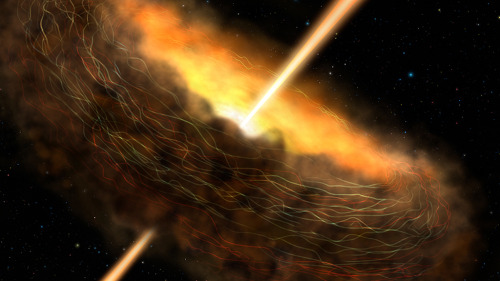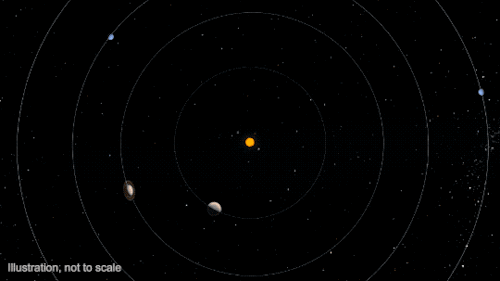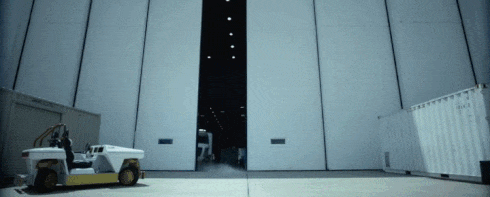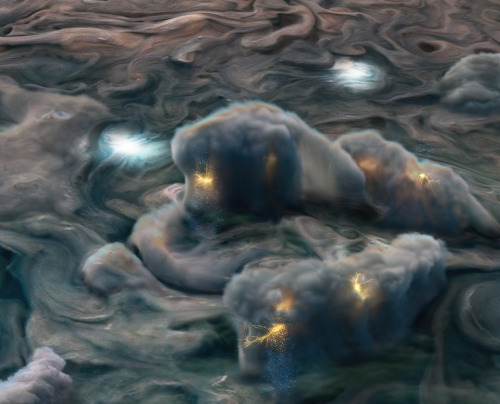10 Amazing Space Discoveries By The World’s Largest Flying Observatory
10 Amazing Space Discoveries by the World’s Largest Flying Observatory

On the night of May 26, 2010, the Stratospheric Observatory for Infrared Astronomy, or SOFIA, the world’s largest flying observatory, first peered into the cosmos. Its mission: to study celestial objects and astronomical phenomena with infrared light. Many objects in space emit almost all their energy at infrared wavelengths. Often, they are invisible when observed in ordinary, visible light. Over the last decade, the aircraft’s 106-inch telescope has been used to study black holes, planets, galaxies, star-forming nebulas and more! The observations have led to major breakthroughs in astronomy, revolutionizing our understanding of the solar system and beyond. To celebrate its 10 years of exploration, here’s a look at the top 10 discoveries made by our telescope on a plane:
The Universe’s First Type of Molecule

Scientists believe that around 100,000 years after the big bang, helium and hydrogen combined to make a molecule called helium hydride. Its recent discovery confirms a key part of our basic understanding of the early universe.
A New View of the Milky Way

More than a pretty picture, this panorama of cosmic scale reveals details that can help explain how massive stars are born and what’s feeding our Milky Way galaxy's supermassive black hole.
When Planets Collide

A double-star system that is more than 300 light-years away likely had an extreme collision between two of its rocky planets. A similar event in our own solar system may have formed our Moon.
How A Black Hole Feasts

Fear not, the dark, my friend. And let the feast begin! Magnetic fields in the Cygnus A galaxy are trapping material where it is close enough to be devoured by a hungry black hole.
Somewhere Like Home

The planetary system around Epsilon Eridani, a star located about 10 light-years away, has an architecture remarkably similar to our solar system. What’s more, its central star is a younger, fainter version of our Sun.
A Quiet Place

Black holes in many galaxies are actively consuming material, but our Milky Way galaxy’s central black hole is relatively quiet. Observations show magnetic fields may be directing material around, not into, the belly of the beast.
The Great Escape

Ever wonder how material leaves a galaxy? The wind flowing from the center of the Cigar Galaxy is so strong it's pulling a magnetic field — and the mass of 50 to 60 million Suns — with it.
Exploding Star, New Worlds

What happens when a star goes boom? It turns out that supernova explosions can produce a substantial amount of material from which planets like Earth can form.
Stellar Sibling Rivalry

They say siblings need time and space to grow, but here’s one that really needs some room. A newborn star in the Orion Nebula is clearing a bubble of space around it, preventing any new luminous family members from forming nearby.
Clues to Life’s Building Blocks

Radiation from stars is making organic molecules in nebula NGC 7023, also known as the Iris Nebula, larger and more complex. The growth of these molecules is one of the steps that could lead to the emergence of life under the right circumstances.
SOFIA is a modified Boeing 747SP aircraft that allows astronomers to study the solar system and beyond in ways that are not possible with ground-based telescopes. Find out more about the mission at www.nasa.gov/SOFIA.
Make sure to follow us on Tumblr for your regular dose of space: http://nasa.tumblr.com
More Posts from Nasa and Others
Say Hello to NGC 6441

Location: In the Scorpius constellation
Distance from Earth: About 44,000 light-years
Object type: Globular star cluster
Discovered by: James Dunlop in 1826
Each tiny point of light in this image is its own star - and there are more than a million of them! This stunning image captured by the Hubble Telescope depicts NGC 6441, a globular cluster that weighs about 1.6 million times the mass of our Sun. Globular clusters like NGC 6441 are groups of old stars held together by their mutual gravitational attraction, appearing nearly spherical in shape due to the density of stars that comprises them. This particular cluster is one of the most massive and luminous in our Milky Way Galaxy. It is also home to a planetary nebula and four pulsars (rotating neutron stars that emit beams of radiation at steady intervals, detected when the beams are aimed at Earth).
Read more information about NGC 6441 here.
Right now, the Hubble Space Telescope is delving into its #StarrySights campaign! Find more star cluster content and spectacular new images by following along on Hubble’s Twitter, Facebook, and Instagram.
Make sure to follow us on Tumblr for your regular dose of space!
Hey! I was wondering how everyone on the ISS adjusts to each other’s culture and language. It seems like it might be hard with language barriers and other factors, to live in a confined space with people from another country. Do others try to teach you their language? Does everyone mostly speak English, or do some people speak Russian?
Can You Guess Which Football Signals Robonaut Is Doing?
Meet Robonaut, our humanoid robot (which means it’s built to look like a person). This makes it easier for Robonaut to do the same jobs as a person.

Robonaut could help with anything from working on the International Space Station to exploring other worlds…and now he might even take up a job as a referee!
We had Robonaut act out a few football signals. Can you guess what they are?!
Signal #1

Signal #2

Signal #3

Signal #4

Signal #5

Signal #6

Signal #7

Signal #8

Signal #9

Get the answers:

But it’s not all fun and games for Robonaut...from performing movements like a referee to helping astronauts on the space station, it’s important to have a robot that can perform the same tasks as humans. Why?

Robonaut could someday be tested outside the space station. This testing would determine how well Robonaut could work with, or instead of, spacewalking astronauts. Designers even have ideas for sending a robot like Robonaut to another world someday. If testing goes well, who knows where Robonaut - or a better robot based on Robonaut - could end up?

To learn more about connections between space and football, visit: https://www.nasa.gov/football
To learn more about Robonaut, visit: https://www.nasa.gov/robonaut2
Make sure to follow us on Tumblr for your regular dose of space: http://nasa.tumblr.com
How does it feel to take a walk in space?
How to Connect with NASA
We're the nation’s space agency, but that doesn’t mean you have to travel to the depths of the universe to stay connected with the awesome stuff we’re doing. There are actually some really easy ways to stay updated on all things space. Check them out:
Apps

We have lots of apps for smartphones and tablets that will make it easier than ever to stay connected to space. Here are a few to pique your interest:
NASA App: Showcases a huge collection of the latest content, including images, videos, mission information, stories, space station sighting opportunities and more! Download: Apple/Android
NASA Spinoff App: This application profiles the best examples of technology that have been transferred from NASA research and missions into commercial products. From life-saving satellite systems to hospital robots, our technologies benefit society. Download: Apple
NASA 3DV App: The 3DV mobile app allows you to examine several of our Deep Space Exploration projects that will take our space program to asteroids, Mars and beyond! Download: Apple/Android
Spacecraft 3D: This augmented reality (AR) application lets you learn about and interact with a variety of spacecraft that are used to explore our solar system, study Earth and observe the universe. Download: Apple/Android
Competitions and Challenges

NASA Solve is an invitation to members of the public to contribute their time and expertise to solving problems and potentially winning prizes as a result of their work. This is a great way for individual members of the public to be a part of the nation’s space program. For a complete list of current challenges and competitions, visit THIS page.
Citizen Science
You don’t have to be a NASA employee to engage in the fun of interpreting scientific data and imagery from our many spacecraft and missions. As part of our Open Government plan, our goal is to promote transparency, participation and collaboration. By expanding the research base and using open innovation, we are all able to benefit from the accumulated findings. You can find data from our missions, research and activities HERE.
Email and Social Media
We have a wide-range of social media accounts here at NASA. Everything from Earth Science to the Mars Curiosity Rover, you can stay updated on many of our missions on many popular social media sites. For a full list of our accounts, visit THIS page.
If you’d like to get space news delivered straight to your inbox, you can sign up for updates and manage preferences HERE.
NASA Socials

What is a NASA Social? We’re glad you asked! These programs provide opportunities for our social media followers to learn and share information about our missions, people and programs. NASA Social includes both special in-person events and social media credentials for individuals who share the news in a significant way. Social events provide the participants with the opportunity to go behind-the-scenes at our facilities and events and speak with scientists engineers, astronauts and managers. Visit THIS page for a list of upcoming NASA Social opportunities.
Make sure to follow us on Tumblr for your regular dose of space: http://nasa.tumblr.com
Our Galaxy is Caught Up in a Giant Cosmic Cobweb! 🕸️

If we could zoom waaaay out, we would see that galaxies and galaxy clusters make up large, fuzzy threads, like the strands of a giant cobweb. But we'll work our way out to that. First let's start at home and look at our planet's different cosmic communities.
Our home star system
Earth is one of eight planets — Mercury, Venus, Earth, Mars, Jupiter, Saturn, Uranus, and Neptune — that orbit the Sun. But our solar system is more than just planets; it also has a lot of smaller objects.

An asteroid belt circles the Sun between Mars and Jupiter. Beyond Neptune is a doughnut-shaped region of icy objects called the Kuiper Belt. This is where dwarf planets like Pluto and Makemake are found and is likely the source of short-period comets (like Haley’s comet), which orbit the Sun in less than 200 years.
Scientists think that even farther out lies the Oort Cloud, also a likely source of comets. This most distant region of our solar system is a giant spherical shell storing additional icy space debris the size of mountains, or larger! The outer edge of the Oort Cloud extends to about 1.5 light-years from the Sun — that’s the distance light travels in a year and a half (over 9 trillion miles).

Sometimes asteroids or comets get ejected from these regions and end up sharing an orbit with planets like Jupiter or even crossing Earth’s orbit. There are even interstellar objects that have entered the inner solar system from even farther than the Oort Cloud, perhaps coming all the way from another star!
Our home galaxy
Let's zoom out to look at the whole Milky Way galaxy, which contains more than 100 billion stars. Many are found in the galaxy’s disk — the pancake-shaped part of a spiral galaxy where the spiral arms lie. The brightest and most massive stars are found in the spiral arms, close to their birth places. Dimmer, less massive stars can be found sprinkled throughout the disk. Also found throughout the spiral arms are dense clouds of gas and dust called nebulae. The Sun lies in a small spiral arm called the Orion Spur.

The Milky Way’s disk is embedded in a spherical “halo” about 120,000 light-years across. The halo is dotted with globular clusters of old stars and filled with dark matter. Dark matter doesn’t emit enough light for us to directly detect it, but we know it’s there because without its mass our galaxy doesn’t have enough gravity to hold together!
Our galaxy also has several orbiting companion galaxies ranging from about 25,000 to 1.4 million light-years away. The best known of these are the Large and Small Magellanic Clouds, which are visible to the unaided eye from Earth’s Southern Hemisphere.
Our galactic neighborhood

The Milky Way and Andromeda, our nearest neighboring spiral galaxy, are just two members of a small group of galaxies called the Local Group. They and the other members of the group, 50 to 80 smaller galaxies, spread across about 10 million light-years.
The Local Group lies at the outskirts of an even larger structure. It is just one of at least 100 groups and clusters of galaxies that make up the Virgo Supercluster. This cluster of clusters spans about 110 million light-years!

Galaxies aren’t the only thing found in a galaxy cluster, though. We also find hot gas, as shown above in the bright X-ray light (in pink) that surrounds the galaxies (in optical light) of cluster Abell 1413, which is a picturesque member of a different supercluster. Plus, there is dark matter throughout the cluster that is only detectable through its gravitational interactions with other objects.
The Cosmic Web
The Virgo Supercluster is just one of many, many other groups of galaxies. But the universe’s structure is more than just galaxies, clusters, and the stuff contained within them.

For more than two decades, astronomers have been mapping out the locations of galaxies, revealing a filamentary, web-like structure. This large-scale backbone of the cosmos consists of dark matter laced with gas. Galaxies and clusters form along this structure, and there are large voids in between.
The scientific visualizations of this “cosmic web” look a little like a spider web, but that would be one colossal spider! <shudder>

And there you have the different communities that define Earth’s place in the universe. Our tiny planet is a small speck on a crumb of that giant cosmic web!
Want to learn even more about the structures in the universe? Check out our Cosmic Distance Scale!
Make sure to follow us on Tumblr for your regular dose of space.
Tour NASA with One Direction

You might have heard, One Direction filmed their ‘Drag Me Down’ music video at NASA’s Johnson Space Center, and we know you’re dying to take a tour of everything they saw. So, here we go…
1) Space Exploration Vehicle (SEV)

Even though Louis is roving around Johnson Space Center in our Space Exploration Vehicle, its intended destination is quite different. The SEV will be used for in-space missions and for surface explorations of planetary bodies, including near-Earth asteroids and Mars!
2) Robonaut
Harry and Robonaut bonded during their visit to Johnson Space Center for the filming of their music video. This robot will help humans work and explore in space. Working side by side with humans, or going where the risks are too great for people, robots will make it so we never get ‘dragged down’!
3) Partial Gravity Simulator & Space Station Mockup Bike

You can find Niall floating around in our Partial Gravity Simulator, aka POGO, in the new music video. This tool is used to provide accurate simulations of reduced gravity. Astronauts use this for training and to learn how to perform tasks in space.
While Niall floats with POGO, Liam is training on the International Space Station Mockup Bike, aka CEVIS. This bike provides aerobic exercise and is used to countermeasure the harmful effects of exposure to microgravity while on the space station.
4) Orion Spacecraft

The Orion spacecraft will be the first of its kind that will carry humans to deep space and to Mars! It will be the safest, most advanced spacecraft ever built, and Harry, Niall, Louis and Liam all got to check it out.
5) T-38 Jets

Flying these T-38 jet trainers are an important part of preparing to be an astronaut. Flying and landing them acts as a real-life simulation for practicing spacecraft operations. They can even fly at supersonic up to Mach 1.6, and can put their pilots through more than seven Gs!

New results from our Juno mission suggest the planet is home to “shallow lightning.” An unexpected form of electrical discharge, shallow lightning comes from a unique ammonia-water solution.
It was previously thought that lightning on Jupiter was similar to Earth, forming only in thunderstorms where water exists in all its phases – ice, liquid, and gas. But flashes observed at altitudes too cold for pure liquid water to exist told a different story. This illustration uses data obtained by the mission to show what these high-altitude electrical storms look like.
Understanding the inner workings of Jupiter allows us to develop theories about atmospheres on other planets and exoplanets!
Illustration Credit: NASA/JPL-Caltech/SwRI/MSSS/Gerald Eichstädt/Heidi N. Becker/Koji Kuramura
Make sure to follow us on Tumblr for your regular dose of space: http://nasa.tumblr.com
-
 cookiehat liked this · 8 months ago
cookiehat liked this · 8 months ago -
 gsunny6 liked this · 2 years ago
gsunny6 liked this · 2 years ago -
 raggedybatman liked this · 2 years ago
raggedybatman liked this · 2 years ago -
 handmeyours liked this · 3 years ago
handmeyours liked this · 3 years ago -
 galaxyharrow reblogged this · 3 years ago
galaxyharrow reblogged this · 3 years ago -
 fairyqueen996 reblogged this · 3 years ago
fairyqueen996 reblogged this · 3 years ago -
 kvaleksy liked this · 3 years ago
kvaleksy liked this · 3 years ago -
 raven6211 liked this · 3 years ago
raven6211 liked this · 3 years ago -
 adricofalzarius liked this · 3 years ago
adricofalzarius liked this · 3 years ago -
 sweetandsadsblog liked this · 3 years ago
sweetandsadsblog liked this · 3 years ago -
 mischief02 liked this · 3 years ago
mischief02 liked this · 3 years ago -
 adm-starblitzsteel-4305 reblogged this · 4 years ago
adm-starblitzsteel-4305 reblogged this · 4 years ago -
 quraninyou liked this · 4 years ago
quraninyou liked this · 4 years ago -
 infinityunitblogblogger reblogged this · 4 years ago
infinityunitblogblogger reblogged this · 4 years ago -
 unlikelyanonymous liked this · 4 years ago
unlikelyanonymous liked this · 4 years ago -
 rage-r liked this · 4 years ago
rage-r liked this · 4 years ago -
 lock-0n liked this · 4 years ago
lock-0n liked this · 4 years ago -
 thelittleoxymoron liked this · 4 years ago
thelittleoxymoron liked this · 4 years ago -
 micaaaa-h liked this · 4 years ago
micaaaa-h liked this · 4 years ago -
 theserpentandthesword reblogged this · 4 years ago
theserpentandthesword reblogged this · 4 years ago -
 hurluberlu31 liked this · 4 years ago
hurluberlu31 liked this · 4 years ago -
 sleepeatdestroyrepeat reblogged this · 4 years ago
sleepeatdestroyrepeat reblogged this · 4 years ago -
 neon-burning liked this · 4 years ago
neon-burning liked this · 4 years ago -
 eldrichlibrarian reblogged this · 4 years ago
eldrichlibrarian reblogged this · 4 years ago -
 thomasswift85 reblogged this · 4 years ago
thomasswift85 reblogged this · 4 years ago -
 foramadmaninabox reblogged this · 4 years ago
foramadmaninabox reblogged this · 4 years ago -
 fenwyld liked this · 4 years ago
fenwyld liked this · 4 years ago -
 starwalkerofthedepths reblogged this · 4 years ago
starwalkerofthedepths reblogged this · 4 years ago -
 heofthebalance reblogged this · 4 years ago
heofthebalance reblogged this · 4 years ago -
 angel-0ver-you reblogged this · 4 years ago
angel-0ver-you reblogged this · 4 years ago -
 angel-0ver-you liked this · 4 years ago
angel-0ver-you liked this · 4 years ago -
 barefootedd liked this · 4 years ago
barefootedd liked this · 4 years ago -
 alittlewitchyplace reblogged this · 4 years ago
alittlewitchyplace reblogged this · 4 years ago -
 cashmoneyravestars liked this · 4 years ago
cashmoneyravestars liked this · 4 years ago -
 stellarmuffin liked this · 4 years ago
stellarmuffin liked this · 4 years ago -
 katdnsm liked this · 4 years ago
katdnsm liked this · 4 years ago
Explore the universe and discover our home planet with the official NASA Tumblr account
1K posts